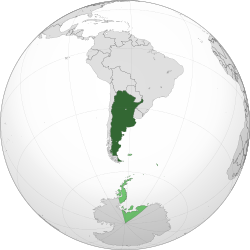Biological and chemical weapons
Argentina acceded to the Geneva Protocol on May 12, 1969 [5] and has been active in non-proliferation efforts, ratifying the Biological Weapons Convention in 1979 [6] and the Chemical Weapons Convention on October 2, 1995. [7]
In September 1991 Argentina, together with Brazil and Chile, signed the Mendoza Declaration, which commits signatories not to use, develop, produce, acquire, stock, or transfer—directly or indirectly—chemical or biological weapons. [8]
Nuclear weapons
Argentina conducted a nuclear weapon research program during the National Reorganization Process regime, in part because of a similar Brazilian program assisted by West Germany. [3] International concern over the possibility of an Argentine nuclear weapons program magnified after the Falklands War in 1982, when the U.S. intelligence community estimated that Argentina could build a nuclear bomb from its civilian nuclear program. [9] Government officials at the time confirmed, in November 1983, that research carried out at the Balseiro Institute's research reactor had yielded the capacity for weapons-grade uranium enrichment. [10] The program was abandoned, however, shortly after the return of democracy, on December 10, 1983. President Raúl Alfonsín placed the nuclear program back under civilian control. [3] The program was also abandoned because Argentina did not have bad relations with Brazil, and because Brazil was wealthier than Argentina and thus more advantaged in an arms race. [11]
After the Brazilian transition to democracy, Argentina and Brazil began cooperating on nuclear non-proliferation. [11] In 1991, the National Congresses of Argentina and Brazil ratified a bilateral inspection agreement that created the Brazilian-Argentine Agency for Accounting and Control of Nuclear Materials (ABACC) to verify both countries' pledges to use nuclear energy only for peaceful purposes. On February 10, 1995, Argentina acceded to the Non-Proliferation Treaty as a non-nuclear weapon state. Argentina continues to use nuclear power in non-military roles, and is noted as an exporter of civilian use nuclear technology. [12]
In 2010, the government announced that it would start working in the creation of a nuclear submarine. [13] This type of submarine uses nuclear power for propulsion. The announcement was highly criticized by politicians from opposing parties. [14]
In accord with three presidential decrees of 1960, 1962 and 1963, Argentina supplied about 90 tons of unsafeguarded yellowcake (uranium oxide) to Israel to fuel the Dimona reactor, reportedly creating the fissile material for Israel's first nuclear weapons. [15]
This page is based on this
Wikipedia article Text is available under the
CC BY-SA 4.0 license; additional terms may apply.
Images, videos and audio are available under their respective licenses.

